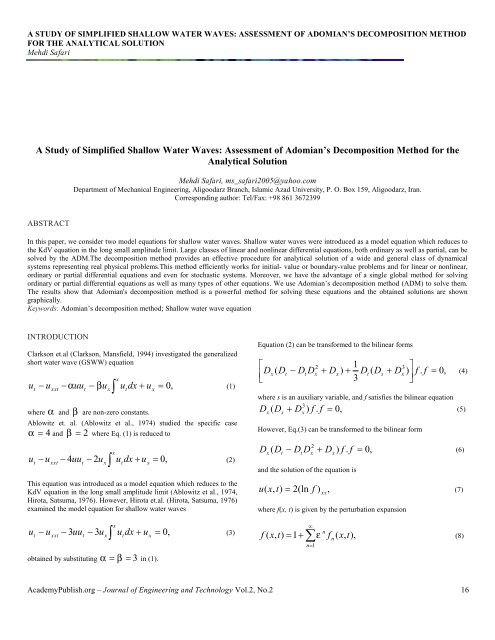Download complete journal in PDF form - Academy Publish
Download complete journal in PDF form - Academy Publish
Download complete journal in PDF form - Academy Publish
Create successful ePaper yourself
Turn your PDF publications into a flip-book with our unique Google optimized e-Paper software.
A STUDY OF SIMPLIFIED SHALLOW WATER WAVES: ASSESSMENT OF ADOMIAN’S DECOMPOSITION METHOD<br />
FOR THE ANALYTICAL SOLUTION<br />
Mehdi Safari<br />
A Study of Simplified Shallow Water Waves: Assessment of Adomian’s Decomposition Method for the<br />
Analytical Solution<br />
Mehdi Safari, ms_safari2005@yahoo.com<br />
Department of Mechanical Eng<strong>in</strong>eer<strong>in</strong>g, Aligoodarz Branch, Islamic Azad University, P. O. Box 159, Aligoodarz, Iran.<br />
Correspond<strong>in</strong>g author: Tel/Fax: +98 861 3672399<br />
ABSTRACT<br />
In this paper, we consider two model equations for shallow water waves. Shallow water waves were <strong>in</strong>troduced as a model equation which reduces to<br />
the KdV equation <strong>in</strong> the long small amplitude limit. Large classes of l<strong>in</strong>ear and nonl<strong>in</strong>ear differential equations, both ord<strong>in</strong>ary as well as partial, can be<br />
solved by the ADM.The decomposition method provides an effective procedure for analytical solution of a wide and general class of dynamical<br />
systems represent<strong>in</strong>g real physical problems.This method efficiently works for <strong>in</strong>itial- value or boundary-value problems and for l<strong>in</strong>ear or nonl<strong>in</strong>ear,<br />
ord<strong>in</strong>ary or partial differential equations and even for stochastic systems. Moreover, we have the advantage of a s<strong>in</strong>gle global method for solv<strong>in</strong>g<br />
ord<strong>in</strong>ary or partial differential equations as well as many types of other equations. We use Adomian’s decomposition method (ADM) to solve them.<br />
The results show that Adomian's decomposition method is a powerful method for solv<strong>in</strong>g these equations and the obta<strong>in</strong>ed solutions are shown<br />
graphically.<br />
Keywords: Adomian’s decomposition method; Shallow water wave equation<br />
INTRODUCTION<br />
Clarkson et.al (Clarkson, Mansfield, 1994) <strong>in</strong>vestigated the generalized<br />
short water wave (GSWW) equation<br />
u<br />
t<br />
uxxt<br />
uut<br />
ux utdx<br />
ux<br />
0,<br />
x<br />
(1)<br />
where and are non-zero constants.<br />
Ablowitz et. al. (Ablowitz et al., 1974) studied the specific case<br />
where Eq. (1) is reduced to<br />
4 and 2<br />
t<br />
uxxt<br />
4uut<br />
2u<br />
x utdx<br />
ux<br />
0,<br />
x<br />
u (2)<br />
This equation was <strong>in</strong>troduced as a model equation which reduces to the<br />
KdV equation <strong>in</strong> the long small amplitude limit (Ablowitz et al., 1974,<br />
Hirota, Satsuma, 1976). However, Hirota et.al. (Hirota, Satsuma, 1976)<br />
exam<strong>in</strong>ed the model equation for shallow water waves<br />
t<br />
uxxt<br />
3uut<br />
3u<br />
x utdx<br />
ux<br />
0,<br />
x<br />
u (3)<br />
obta<strong>in</strong>ed by substitut<strong>in</strong>g 3 <strong>in</strong> (1).<br />
Equation (2) can be trans<strong>form</strong>ed to the bil<strong>in</strong>ear <strong>form</strong>s<br />
<br />
<br />
D<br />
<br />
( D D D<br />
D<br />
1<br />
) Dt<br />
( D<br />
3<br />
D<br />
<br />
)<br />
<br />
f . f<br />
<br />
0,<br />
2<br />
3<br />
x t t x x<br />
s x<br />
(4)<br />
where s is an auxiliary variable, and f satisfies the bil<strong>in</strong>ear equation<br />
D ( D<br />
D<br />
) f . f<br />
0,<br />
3<br />
x s x<br />
(5)<br />
However, Eq.(3) can be trans<strong>form</strong>ed to the bil<strong>in</strong>ear <strong>form</strong><br />
D ( D D D<br />
D<br />
) f . f<br />
0,<br />
2<br />
x t t x x<br />
(6)<br />
and the solution of the equation is<br />
u x,<br />
t)<br />
2(ln f ) ,<br />
(7)<br />
(<br />
xx<br />
where f(x, t) is given by the perturbation expansion<br />
<br />
n1<br />
n<br />
f ( x,<br />
t)<br />
1<br />
f ( x,<br />
t),<br />
(8)<br />
n<br />
<strong>Academy</strong><strong>Publish</strong>.org – Journal of Eng<strong>in</strong>eer<strong>in</strong>g and Technology Vol.2, No.2 16












